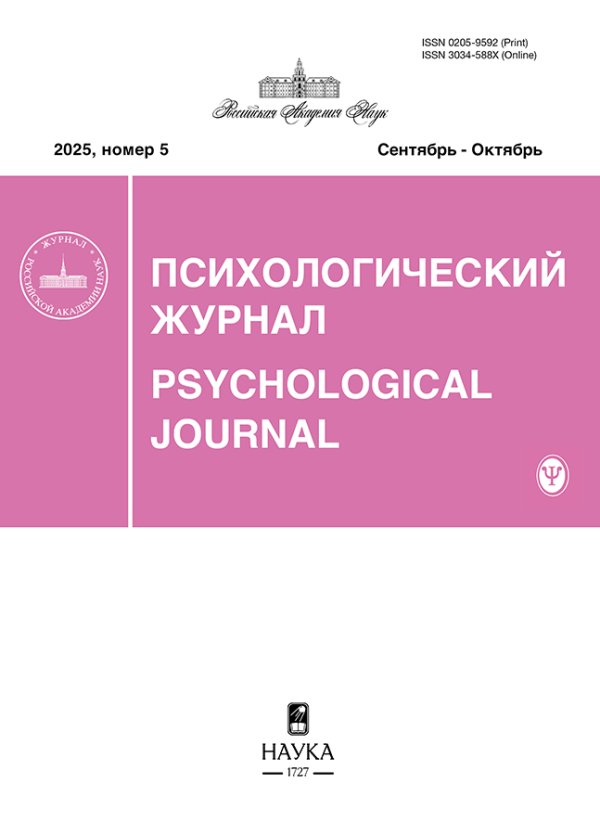Методы измерения эмоциональной дифференцированности: сравнительный анализ
- Авторы: Сучкова Е.А.1, Люсин Д.В.2
-
Учреждения:
- Национальный исследовательский университет “Высшая школа экономики”
- ФГБУН Институт психологии РАН, Национальный исследовательский университет “Высшая школа экономики”
- Выпуск: Том 44, № 6 (2023)
- Страницы: 77-85
- Раздел: Методы и методики
- URL: https://journals.rcsi.science/0205-9592/article/view/251234
- DOI: https://doi.org/10.31857/S020595920029013-0
- ID: 251234
Цитировать
Полный текст
Аннотация
Ключевые слова
Об авторах
Е. А. Сучкова
Национальный исследовательский университет “Высшая школа экономики”Российская Федерация, Москва
Д. В. Люсин
ФГБУН Институт психологии РАН, Национальный исследовательский университет “Высшая школа экономики”Российская Федерация, Москва
Список литературы
- Сучкова Е.А. Эмоциональная дифференцированность: определение, варианты операционализации, перспективы исследований // Психологические исследования. 2021. Т. 14. № 79. С. 2.
- Aaron R.V., Snodgress M.A., Blain S.D., Park S. Affect labeling and other aspects of emotional experiences in relation to alexithymia following standardized emotion inductions // Psychiatry Research. 2018. V. 262. P. 115–123.
- Barrett L.F. Feelings or Words? Understanding the Content in Self-Report Ratings of Experienced Emotion // Journal of Personality and Social Psychology. 2004. V. 87. № 2. P. 266–281.
- Barrett L.F., Gross J., Christensen T.C., Benvenuto M. Knowing what you’re feeling and knowing what to do about it: Mapping the relation between emotion differentiation and emotion regulation // Cognition and Emotion. 2001. V. 15. № 6. P. 713–724.
- Boden M.T., et al. Are emotional clarity and emotion differentiation related? // Cognition and Emotion. 2013. V. 27. № 6. P. 961–978.
- Demiralp E., et al. Feeling blue or turquoise? Emotional differentiation in major depressive disorder // Psychological Science. 2012. V. 23. № 11. P. 1410–1416.
- Erbas Y., et al. Emotion differentiation dissected: between-category, within-category, and integral emotion differentiation, and their relation to well-being // Cognition and Emotion. 2019. V. 33. № 2. P. 258–271.
- Erbas Y., et al. Emotion differentiation in autism spectrum disorder // Research in Autism Spectrum Disorders. 2013. V. 7. № 10. P. 1221–1227.
- Erbas Y., et al. Why I don’t always know what I’m feeling: the role of stress in within-person fluctuations in emotion differentiation // Journal of Personality and Social Psychology. 2018. V. 115. № 2. P. 179–191.
- Erbas Y., et al. Negative emotion differentiation: its personality and well-being correlates and a comparison of different assessment methods // Cognition and Emotion. 2014. V. 28. № 7. P. 1196–1213.
- Giraudeau B. Negative values of the intraclass correlation coefficient are not theoretically possible // Journal of Clinical Epidemiology. 1996. V. 49. P. 1205–1206.
- Kalokerinos E.K., Erbas Y., Ceulemans E., Kuppens P. Differentiate to regulate: Low negative emotion differentiation is associated with ineffective use but not selection of emotion-regulation strategies // Psychological Science. 2019. V. 30. P. 863–879.
- Kashdan T.B., Barrett L.F., McKnight P.E. Unpacking emotion differentiation transforming unpleasant experience by perceiving distinctions in negativity // Current Directions in Psychological Science. 2015. V. 24. № 1. P. 10–16.
- Kashdan T.B., Ferssizidis P., Collins R.L., Muraven M. Emotion differentiation as resilience against excessive alcohol use: An ecological momentary assessment in underage social drinkers // Psychological Science. 2010. V. 21. № 9. P. 1341–1347.
- Koch A., Alves H., Krüger T., Unkelbach C. A general valence asymmetry in similarity: Good is more alike than bad // Journal of Experimental Psychology: Learning, Memory, and Cognition. 2116. V. 42. № 8. P. 1171–192.
- Kurdi B., Lozano S., Banaji M.R. Introducing the Open Affective Standardized Image Set (OASIS) // Behavior Research Methods. 2017. V. 49. P. 457–470.
- Nunnally, J., Bernstein, I. Psychometric theory. 3rd ed // McGraw-Hill Series in Psychology. Tata McGraw-Hill Ed. New Delhi: 2010.
- Lang P.J., Bradley M.M., and Cuthbert B.N. International Affective Pictures System (IAPS): Technical manual and affective ratings (tech.Rep.A-4). Gainesville: University of Florida, Center for Research in Psychophysiology, 1995.
- Mestdagh M., et al. m-Path: An easy-to-use and flexible platform for ecological momentary assessment and intervention in behavioral research and clinical practice. 2022, January 25
- Mikhail M.E., et al. Low emotion differentiation: An affective correlate of binge eating? // International Journal of Eating Disorders. 2019. V. 53. P. 412–421.
- Pond R.S., et al. Emotion differentiation moderates aggressive tendencies in angry people: A daily diary analysis // Emotion. 2012. V. 12. № 2. P. 326–337.
- Selby E.A., et al. Nothing Tastes as Good as Thin Feels: Low Positive Emotion Differentiation and Weight-Loss Activities in Anorexia Nervosa // Clinical Psychological Science. 2014. V. 4. № 2. P. 514–531.
- Smidt K. Suvak M. A Brief, but Nuanced, Review of Emotional Granularity and Emotion Differentiation Research // Current Opinion in Psychology. 2015. V. 3.
- Thompson R., Springstein T., Boden M. Gaining clarity about emotion differentiation // Social and Personality Psychology Compass. 2021. V. 15. P. 1–14.
- Vedernikova E., Kuppens P., Erbas Y. From Knowledge to Differentiation: Increasing Emotion Knowledge Through an Intervention Increases Negative Emotion Differentiation // Frontiers in Psychology. 2021. V. 12:703757.
- Widdershoven R., et al. Effect of self-monitoring through experience sampling on emotion differentiation in depression // Journal of Affective Disorders. 2019. V. 244. P. 71–77.
Дополнительные файлы










